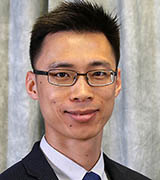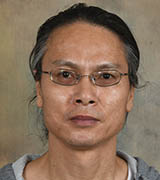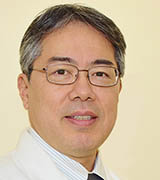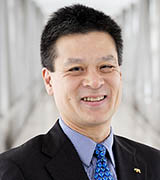Colleagues: Recently Tenured
Meet your recently tenured colleagues: Christina Annunziata (NCI-CCR), T.C. “Kelvin” Choi (NIMHD), Tae-Wook Chun (NIAID), Heidi H. Kong (NIAMS), Da-Ting Lin (NIDA), Susan L. Moir (NIAID), Keisuke (Chris) Nagao (NIAMS), John Ngai (NINDS), Kandice Tanner (NCI-CCR, pictured), and Stephen Whitehead (NIAID)
CHRISTINA ANNUNZIATA, M.D., PH.D., NCI-CCR
Senior Investigator and Head, Translational Genomics Section, Women’s Malignancies Branch, Center for Cancer Research, National Cancer Institute

Education: Georgetown University College of Arts and Sciences, Washington, D.C. (B.S. in biology, Ph.D. in pathology); Georgetown University School of Medicine, Washington, D.C. (M.D.)
Training: Resident, Department of Internal Medicine, Georgetown University School of Medicine; Medical Oncology Fellow and later Research Fellow, Medical Oncology Branch, NCI
Came to NIH: In 2002 for training
Outside interests: Cooking; cycling; and doing yoga
Website: https://irp.nih.gov/pi/christina-annunziata
Research interests: Ovarian cancer accounts for more deaths than any other cancer of the female reproductive system, resulting in over 15,000 deaths annually. Most patients respond to platinum-based chemotherapy, but more than 70% of people with advanced ovarian cancer relapse within 24 months. My lab has identified a subset of ovarian cancer cell lines that are dependent on the NF-kappa-B signaling pathway for growth and survival. NF-kappa-B is a protein complex that controls DNA transcription, cytokine production, and cell survival. Aberrant NF-kappa-B signaling has been identified in tumors of epithelial origin including breast, colon, lung, and ovarian carcinomas.
My lab’s genomic profiling and functional screens identified both downstream targets and upstream regulators of this pathway, defining subgroups of patients whose cancers depend on NF-kappa-B and opening up possibilities for novel therapies to treat ovarian cancer. I am conducting several clinical trials to better understand both predictive and pharmacodynamic markers of treatment response. One of my earlier clinical trials used a synthetic small molecule called birinapant to block NF-kappa-B signaling and induce apoptosis in ovarian cancer (Cancer 122:588–597, 2016). This study led us to identify other pathway inhibitors that are synergistic in killing ovarian cancer cells. We are about to open a new clinical trial with the combination of small molecules that inhibit two pathways.
A second focus of my lab and clinic is immunotherapy for ovarian cancer. I participated in a recent study to assess the efficacy and safety of avelumab in 125 women with previously treated recurrent or refractory ovarian cancer. We found that avelumab demonstrated antitumor activity and acceptable safety in these patients (JAMA Oncol 5:393–401, 2019; DOI:10.1001/jamaoncol.2018.625).
In addition, we have focused on enhancing the innate immune system to overcome the immune-suppressive environment of the abdominal cavity, where ovarian cancer grows. We completed a phase 1 clinical trial using interferons alpha and gamma to stimulate monocytes that we injected directly into the patients’ abdomens (J Transl Med 16:196, 2018). This therapy is very promising in that it could be a platform on which to layer personalized immunotherapy approaches.
Ongoing studies of patient samples from this trial will help us to design the next steps in improving this therapy as well.
T.C. “KELVIN” CHOI, PH.D., M.P.H., NIMHD
Senior Investigator, Social and Behavioral Group, National Institute on Minority Health and Health Disparities

Education: The Hong Kong Polytechnic University, Hong Kong (B.Sc. in physiotherapy); University of Minnesota at Minneapolis (M.P.H. in community health education and Ph.D. in epidemiology)
Training: Attended training institutes through NIH’s Office of Behavioral and Social Sciences Research and NIDA; Fundamentals of Team Science and the Science of Team Science through the National Science Foundation and the University of Central Florida
Before coming to NIH: Various positions including assistant professor at the University of Minnesota School of Public Health, Division of Epidemiology and Community Health; clinic manager and physiotherapist, Cosmo Physiotherapy Center (Hong Kong)
Came to NIH: In 2013 as a Stadtman Investigator in NIMHD
Outside interests: Enjoying nature (hiking, biking, canoeing, and camping) and being the father of a synchronized ice skater
Website: https://irp.nih.gov/pi/kelvin-choi
Research interests: I am interested in the interconnected and potentially reciprocal relationships between the social determinants of health and tobacco exposure and use, and the social and environmental factors that explain these relationships. For example, we found that smoking influences sleep quality in youth, which can affect their academic performance and subsequent college enrollment. We also found that cigarette smoking during the high school years is associated with a lower likelihood of enrolling in post-secondary education, especially four-year college programs. In another study, we found that youth exposure to secondhand smoke was associated with later lower academic performance (Am J Prev Med 58:776–782, 2020; DOI:10.1016/j.amepre.2019.12.020).
My team is also investigating how tobacco companies’ marketing strategies cultivate and foster tobacco use among adolescents and adults and how the effects differ by demographics and socioeconomic status (SES). In one study, we found that adults of lower SES were more likely to be exposed to tobacco discount coupons, and this exposure was related to the progression and continuation of smoking (Nicotine Tob Res 20:1095–1100, 2018; DOI:10.1093/ntr/ntx141). We are also investigating the physiological and neurological responses to tobacco-marketing materials among smokers; what we learn will inform both how best to regulate these materials and design anti-tobacco messages.
In addition, we are examining how to leverage marketing principles (including price, placement, promotion, and products) to reduce tobacco-use disparities, particularly among young adults. I am currently working with collaborators to develop a computer simulation that can forecast the potential impact of tobacco–marketing regulations on tobacco-use disparities.
The knowledge gained from these investigations will be used to construct more effective anti-tobacco interventions and messages that are tailored to smokers of disadvantaged populations, and public-health interventions for other health-risk behaviors.
TAE-WOOK CHUN, PH.D., NIAID
Senior Investigator and Chief, HIV Immunovirology Section, Laboratory of Immunoregulation, National Institute of Allergy and Infectious Diseases

Education: California State University at San Bernardino, California (B.S. in biology); Johns Hopkins University School of Medicine, Baltimore (Ph.D. from the Biochemistry, Cellular and Molecular Biology Graduate Program)
Training: Research fellow, Laboratory of Immunoregulation at NIAID
Came to NIH: In 1997 for training; became a staff scientist in 2001, an associate scientist in 2009, and an Earl Stadtman Investigator in 2016
Outside interests: Hanging out with Canada Geese on campus and Panda Cam watching
Website: https://irp.nih.gov/pi/tae-wook-chun
Research interests: Although antiretroviral therapy reduces the amount of human immunodeficiency virus (HIV) in blood, it does not completely eradicate the virus in infected individuals. Persistently infected CD4 T-cell reservoirs have long half-lives and could contribute to viral rebound when antiretroviral therapy is interrupted. Treatment for HIV, therefore, has to be continued through life. My group’s research focuses on 1) delineating the role of viral reservoirs in the pathogenesis of HIV disease; 2) examining host and viral factors that contribute to the maintenance of HIV reservoirs; and 3) developing therapeutic strategies aimed at achieving durable virologic control in infected individuals in the absence of antiretroviral therapy.
We conduct comprehensive genetic, immunologic, and virologic analyses of T cells in diverse cohorts of HIV-infected individuals. In so doing, we are addressing fundamental pathogenic questions, such as elucidating mechanisms of viral persistence; examining the role of the host immunity in containment of viral replication; and evaluating promising novel therapeutic agents in both ex vivo and in vivo settings (J Infect Dis jiaa270, 2020); J Clin Invest 129:4832–4837, 2019; PLoS Pathog 14:e1006792, 2018).
In addition to our bench research, we have conducted several phase 1 clinical trials in close collaboration with the NIAID HIV clinic, with the ultimate goal of developing safe, effective, and scalable therapeutic strategies that would allow HIV-infected individuals to control viral replication without having to use antiretroviral drugs daily. Among the multiple therapeutic trials we have conducted over the past several years, two were directed at blocking HIV by using monoclonal antibodies that bind either the virus or the human receptor for the virus, CD4 (N Engl J Med 375:2037–2050, 2016; N Engl J Med 380:1535–1545, 2019).
Additional clinical trials are currently being developed to explore the possibility of achieving complete remission of HIV in infected individuals through the administration, twice a year, of a combination of long-acting anti-HIV antibodies and antiretroviral drugs.
HEIDI H. KONG, M.D., M.H.Sc., NIAMS
Senior Investigator, Cutaneous Microbiome and Inflammation Section, Dermatology Branch, National Institute of Arthritis and Musculoskeletal and Skin Diseases; Adjunct Investigator, Cancer and Inflammation Program, Center for Cancer Research, National Cancer Institute

Education: Stanford University, Stanford, California (B.S. in biological sciences); Baylor College of Medicine, Houston (M.D.); Duke University, Durham, North Carolina (M.H.Sc.)
Training: Residency and chief residency in Dermatology, Duke University; clinical research fellow, NCI’s Dermatology Branch
Came to NIH: In 2005 for training
Outside interests: Spending time and traveling with family; baking; reading
Website: https://irp.nih.gov/pi/heidi-kong
Research interests: My group integrates advanced genomics and translational research expertise in dermatologic disorders to study human skin microbes and gain insights into the pathogenesis of inflammatory skin diseases. My lab’s work has advanced our understanding of human skin microbial communities.
In particular, we study the diversity and complexity of bacterial, fungal, and viral communities in healthy skin and in eczema from patients with atopic dermatitis and with primary immunodeficiencies. We have demonstrated how the skin microbial communities can vary based on the specific location on the body. We found that despite the skin’s exposure to the external environment, its microbial communities were largely stable over time.
In addition, we know that the skin microbiome can be distinguished in certain skin diseases and with specific immunodeficiencies. While we found that disease flare-ups in patients with atopic dermatitis are linked with higher percentages of Staphylococcus aureus or Staphylococcus epidermidis, patients with a rare primary immunodeficiency (DOCK8, or dedicator of cytokinesis 8, deficiency) have higher proportions of DNA viruses on their skin.
These studies highlight how the host shapes, and in turn may be shaped by, the skin microbiome. Our current efforts are focused on deeper investigations of these host-microbial interactions.
DA-TING LIN, PH.D., NIDA
Senior Investigator and Chief, Neural Engineering Section, Behavioral Neuroscience Branch, National Institute on Drug Abuse

Education: University of Science and Technology of China, Hefei, China (B.S. in biology); University of Texas Health Science Center at San Antonio, San Antonio, Texas (Ph.D. in cell biology)
Training: Postdoctoral fellow, Department of Neuroscience, Johns Hopkins University (Baltimore)
Before coming to NIH: Assistant professor, The Jackson Laboratory (Bar Harbor, Maine) and Department of Medicine, Tufts University School of Medicine (Boston)
Came to NIH: In 2013 as chief of NIDA’s Optical Imaging Core
Outside interests: Playing soccer
Website: https://irp.nih.gov/pi/da-ting-lin
Research interests: I am studying the neural circuit mechanisms involved in long-term drug addiction and relapse. My laboratory is developing and applying in vivo optical imaging methods, as well as computational methods for data analysis, to measure neural-circuit dysfunction that may lead to long-term substance abuse and cause patients in recovery to relapse.
Neuroscientists and engineers are increasingly interested in studying neuronal activities at the microcircuit level and are pushing the limits in developing miniature in vivo imaging systems. This interdisciplinary effort has led to a widespread use of wearable miniature microscopes, which are constantly improving in size, cost, spatial and temporal resolutions, and signal-to-noise ratio.
Right now my group is developing imaging systems that can visualize neural activity from deep-brain regions in animals. Such systems are becoming more important for understanding neural-encoding mechanisms underlying cognitive functions. We independently developed a miniScope (a miniature fluorescence microscope), an imaging system that allows the simultaneous recording of activity of hundreds of neurons in deep-brain regions of freely behaving mice. The miniScope expands the realm of possible behavioral experiments for in vivo imaging studies (Neuron 92:202–213, 2016 and Neuron 100:700–714.e9, 2018). We are continuing to explore in vivo deep-brain imaging of neuronal circuit activity and refining techniques to measure neuronal dysfunction.
SUSAN L. MOIR, PH.D., NIAID
Senior Investigator and Chief, B-Cell Immunology Section, Laboratory of Immunoregulation, National Institute of Allergy and Infectious Diseases

Education: University of Guelph, Guelph, Ontario, Canada (B.S. in biological science, minor in biotechnology); Université du Québec, Institut Armand-Frappier, Laval, Québec, Canada (M.Sc. in virology and immunology); Université Laval, Québec City, Québec, Canada (Ph.D. in microbiology and immunology)
Training: Postdoctoral visiting fellow, NIAID
Came to NIH: In 1996 for training; became staff scientist in 2006, associate scientist in 2010, and Stadtman Investigator in 2015
Outside interests: Spending time with her family; enjoying outdoor activities; and being inspired by market-to-table-style cooking to share meals with others
Website: https://irp.nih.gov/pi/susan-moir
Research interests: The primary focus of my research program is to study the role of B cells in the pathogenesis of human immunodeficiency virus (HIV) disease, with the ultimate goal of filling gaps in knowledge about humoral immunity against the virus. This knowledge is critical to the development of an effective antibody-based vaccine and for the advancement of immunotherapeutic interventions in HIV-infected individuals. My group’s approach involves assessing transcriptional, phenotypic, and functional attributes of B cells that circulate in the peripheral blood and those that reside in tissues, particularly lymph nodes and bone marrow.
A major focus of our research also includes identifying and characterizing various subsets of B cells—in the blood and tissues of healthy individuals—that are overexpressed at various stages of HIV infection. We have shown that several of these subsets may be responsible for various manifestations associated with HIV disease, including hypergammaglobulinemia (excess globulins in the blood), inadequate response to vaccination, altered homeostasis associated with lymphopenia (lower than normal number of lymphocytes) that occurs in late HIV disease and AIDS, reduced responsiveness of B cells due to immune exhaustion and other inhibitory effects, and inefficient antibody responses due to altered maturation of B cells in lymphoid tissues (Nat Rev Immunol 9:235–245, 2009; Nat Immunol 19:1001–1012, 2018; Sci Transl Med 11:eaax0904, 2019).
Another long-term goal is to apply our knowledge of B cells in HIV to other immune-mediated diseases, particularly primary immune deficiencies in which B cells play a pathogenic role.
KEISUKE (CHRIS) NAGAO, M.D., PH.D., NIAMS
Senior Investigator and Head, Cutaneous Leukocyte Biology Section, National Institute of Arthritis and Musculoskeletal and Skin Diseases

Education: Keio University School of Medicine, Tokyo, Japan (M.B., M.D., Ph.D. in microbiology)
Training: Residency, Department of Dermatology, Keio University School of Medicine; Department of Anesthesiology, Tokyo Dental College Hospital, Tokyo, Japan (4 months); visiting fellow (nonclinical), Dermatology Branch, Center for Cancer Research, National Cancer Institute
Before returning to NIH: Senior assistant professor (with tenure), Department of Dermatology, Keio University School of Medicine
Came to NIH: In 2005–2008 for training; returned in 2014 as Stadtman Investigator in NCI’s Dermatology Branch
Outside interests: Reading; exercising
Website: https://irp.nih.gov/pi/keisuke-chris-nagao
Research interests: I am a dermatologist with a longstanding interest in skin immunology and immune-mediated diseases. My research program aims to advance our knowledge on how the skin functions as an immunological organ. We study mechanisms that underlie skin immunity and host-microbiota crosstalk during health and inflammatory diseases. Over recent years, we have identified hair follicles as control towers of skin immunity: the follicles guide the localization of skin-resident leukocytes and enhance their survival by producing chemokines and cytokines. In turn, leukocytes, such as the innate lymphoid cells, communicate with hair follicles to tune the balance of the microbiota on the skin surface.
We have also determined that the alteration of the host-microbial relationship drives atopic skin inflammation. The skin of atopic dermatitis (AD) patients is commonly colonized with Staphylococcus aureus. For decades, scientists have debated whether this bacterium contributes to AD pathophysiology. By generating an AD mouse model that recapitulated S. aureus susceptibility in humans, we demonstrated S. aureus to be a crucial driver of skin inflammation, thereby providing an answer to a longstanding question.
We leverage advances in sequencing technologies to understand disease pathophysiology directly in humans. Diseases of interest include primary immunodeficiencies and intractable immune-mediated diseases such as severe drug hypersensitivities in which we use single-cell RNA sequencing to tailor personalized medicine. We will continue to use approaches in experimental models and expand our studies on human diseases to understand core and translatable mechanisms that regulate skin immunity and facilitate host-microbial symbiosis.
JOHN NGAI, PH.D., NINDS
Senior Investigator, National Institute of Neurological Disorders and Stroke; Director of NIH BRAIN Initiative

Education: Pomona College, Claremont, California (B.A. in chemistry and zoology); Harvard Medical School, Boston (Program on Cell and Developmental Biology); California Institute of Technology, Pasadena, California (Ph.D. in biology)
Training: Postdoctoral fellow, California Institute of Technology and Howard Hughes Medical Institute/Columbia University College of Physicians and Surgeons (New York)
Before coming to NIH: Professor of Neurobiology, Department of Molecular and Cell Biology, and Coates Family Professor of Neuroscience, Helen Wills Neuroscience Institute, University of California at Berkeley (Berkeley, California)
Came to NIH: In 2020
Outside interests: Doing photography; enjoying food and wine
Website: https://www.ninds.nih.gov/About-NINDS/Who-We-Are/staff/John-Ngai
Research interests: The generation of cellular diversity in the nervous system requires the specification and differentiation of a multitude of cell lineages from multipotent progenitor cells. The regulatory programs governing this process remain incompletely characterized, however, in part because of the difficulty in studying neuronal progenitor cells in their native environments. My lab uses the mammalian olfactory epithelium as a model for addressing this challenge.
Primary sensory neurons in the olfactory epithelium are continuously regenerated throughout adult life via the proliferation and differentiation of multipotent neural progenitor cells. Upon severe injury, these adult tissue stem cells are activated and go on to reconstitute all of the cellular constituents of this sensory epithelium. The regenerative capacity of the olfactory epithelium therefore presents a powerful and experimentally accessible paradigm for elucidating the mechanisms regulating neural stem-cell function.
We are using a variety of approaches to unravel the molecular and cellular mechanisms regulating olfactory stem cells and olfactory neurogenesis in the mouse. For example, we use conditional genetic knockouts to investigate the roles of certain transcription factors and intracellular signaling pathways in promoting stem-cell self-renewal, proliferation, and differentiation.
As a complementary approach, we also apply single-cell transcriptomic and single-cell epigenomic analyses to identify the genetic and epigenetic programs that both define and regulate olfactory neurogenesis during regeneration.
Our studies provide a model for understanding the mechanisms regulating neural stem cells and lay the groundwork for the future development of treatments and therapeutics to ameliorate tissue damage and degeneration in the nervous system.
KANDICE TANNER, PH.D., NCI-CCR
Senior Investigator and Head, Tissue Morphodynamics Section, Laboratory of Cell Biology, Center for Cancer Research, National Cancer Institute

Education: South Carolina State University, Orangeburg, South Carolina (B.S. in electrical engineering technology and physics); University of Illinois at Urbana-Champaign, Urbana, Illinois (M.S. in physics; Ph.D. in physics)
Training: Postdoctoral fellowships at University of California at Irvine (Irvine, California), University of California at Berkeley (Berkeley, California)/Lawrence Berkeley National Laboratory (Berkeley, California)
Came to NIH: In 2012 as a Stadtman Investigator
Outside interests: Kickboxing; running; reading
Website: https://irp.nih.gov/pi/kandice-tanner
Research interests: My lab focuses on understanding the metastatic traits that allow tumor cells to colonize secondary organs. Some exciting findings in the field of mechanobiology have demonstrated that biophysical properties such as cell shape, mechanical phenotype, topography, hemodynamic forces, and pressure can modulate how genes are activated and silenced in key processes involving cell growth, migration, invasion, and metabolism. We have developed biophysical tools and novel animal models to understand how physical cues from the tissue microenvironment drive organ-specific metastasis. We aim to understand what drives organ targeting and secondary-tumor outgrowth.
In one study, we discovered that the physical properties of blood vessels regulate organ selectivity in vivo. We combined intravital imaging, vessel-topographical analysis, and mechanical mapping—and the use of home-built optical tweezers—in a zebrafish model. This work was the first demonstration that physical properties of blood vessels can regulate how metastasizing tumor cells in vivo select organs to migrate to (Cell Syst 9:187–206.e.a6, 2019).
We also found that after tumor cells leave the circulation, they must adapt to a tissue environment of different properties from that of the primary tumor. Using 3D culture models, we have uncovered a novel mathematical formulation that decribes the coupling of 3D microscale cell extracellular-matrix mechanics (Proc Natl Acad Sci U S A 116:14448–14455, 2019). Moving forward, we wish to leverage our understanding of tissue biophysics to define a biomarker that will be predictive of the site of the secondary lesion.
STEPHEN WHITEHEAD, PH.D., NIAID
Senior Investigator and Chief, Arbovirus Vaccine Research Section, Laboratory of Viral Diseases, National Institute of Allergy and Infectious Diseases

Education: Brigham Young University, Provo, Utah (B.S. microbiology; M.S. in microbiology); Oregon State University, Corvallis, Oregon (Ph.D. in microbiology)
Training: Postdoctoral fellow, Rockefeller University (New York) and NIAID; senior staff fellow, NIAID
Came to NIH: In 1995 for training; became a staff scientist in 1999
Outside interests: Loves spinging time with his family; working in the garden; and cooking. He holds a certificate in Chinese cuisine.
Website: TBD
Research interests: My lab is developing and evaluating vaccines against mosquito-borne flaviviruses, which include dengue virus (DENV), Zika virus (ZIKV), West Nile virus, and Japanese encephalitis virus (JEV). We are particularly focused on developing a tetravalent dengue vaccine called TV003. Because previous infection with one DENV serotype can increase the risk for serious disease after infection with a different serotype, a successful vaccine will need to protect against all four DENV serotypes.
I have long-standing collaborations with investigators from Johns Hopkins University (JH, Baltimore) and the University of Vermont (UVM, Burlington, Vermont). Among our many studies of the dengue vaccine TV003, one was a pivotal clinical demonstration showing that TV003 elicited complete protection against DENV in a human challenge model: 21 vaccine recipients were protected and 20 placebo recipients were not (Sci Transl Med 8:330ra36, 2016). In another clinical study with JH, UVM, and NIAID colleagues, we demonstrated that TV003 was fully potent as a single-dose vaccine (J Infect Dis 214:832–835, 2016); and we also showed that TV003 is well tolerated and highly immunogenic in subjects with flavivirus exposure before vaccination (PLoS Negl Trop Dis 11:e0005584., 2017). In addition to recent clinical studies in Thailand and Taiwan, a key phase 3 study of TV003 is nearing completion in Brazil. The vaccine technology has been licensed to seven companies and institutes across the world for further development and commercialization.
My group has also made important advancements with other flaviviruses. For example, we are developing live attenuated ZIKV and JEV vaccines that are compatible with the DENV vaccine, thus enabling simultaneous vaccination against DENV and either ZIKV or JEV. Novel vaccine candidates for ZIKV are being developed with Alexander Pletnev in NIAID’s Laboratory of Infectious Diseases.
This page was last updated on Monday, March 21, 2022
